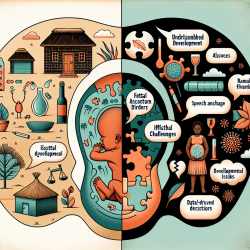As professionals dedicated to supporting children with autism spectrum disorders (ASD), it's imperative to continuously seek out and critically assess innovative and alternative therapies that could enhance our practice and the lives of those we serve. A notable study by Bryna Siegel, PhD, from the University of California, San Francisco, delves into two such therapies: Facilitated Communication (F/C) and Auditory Integration Training (AIT). This blog aims to unpack the findings from Siegel's research and explore how these insights can either be integrated into our practice or guide us towards further research.
Understanding the Therapies
Facilitated Communication and Auditory Integration Training were developed with the intention of improving communication skills in children with autism. F/C was designed for individuals who are nonverbal and have found limited success with other augmentative communication forms, while AIT targeted those with some expressive skills but faced auditory processing challenges that affected their language development.
Critical Analysis of Facilitated Communication
The study critically examines the effectiveness of F/C, revealing that despite its widespread promotion and use, empirical evidence supporting its efficacy is lacking. Initial enthusiasm for F/C was based on anecdotal success stories and the appealing notion that it could unlock the hidden communicative potential of nonverbal individuals. However, subsequent research, including controlled studies, failed to validate these claims, consistently showing that the facilitator, not the individual with autism, was the source of the communication.
Auditory Integration Training: A Review
AIT, developed to address auditory hypersensitivity and processing issues in children with ASD, has similarly been subjected to scrutiny. Despite theoretical underpinnings suggesting that modulating auditory input could lead to improvements in language and behavioral domains, rigorous research has not substantiated these claims. Clinical trials and reviews have shown mixed results, with no significant evidence supporting AIT's effectiveness over control conditions.
Implications for Practice
The findings from Siegel's study prompt us to approach alternative therapies with a critical and scientific mindset. While the desire to find effective interventions is understandable, it's crucial to base our practices on methods that have been empirically validated. Here are some recommendations for practitioners:
- Remain Informed: Stay abreast of the latest research and developments in autism therapies. Critical engagement with the literature allows us to discern between promising practices and those lacking evidence.
- Engage in Further Research: Where evidence is inconclusive or absent, there's a need for well-designed studies to explore the potential benefits of alternative therapies further.
- Adopt Evidence-Based Practices: Prioritize interventions with strong empirical support, ensuring that the therapies we endorse and apply offer the best outcomes for individuals with ASD.
- Advocate for Rigorous Evaluation: Encourage and participate in the rigorous evaluation of new and existing therapies to build a robust evidence base that informs practice.
- Educate and Support Families: Help families navigate the complex landscape of autism therapies. Provide them with information on evidence-based practices and guide them in making informed decisions.
Conclusion
The journey towards effective treatment for ASD is ongoing and requires a commitment to scientific principles and compassionate care. While F/C and AIT offer insights into the challenges and complexities of developing interventions for communication disorders in autism, they also underscore the importance of evidence in guiding our practices. By adhering to a research-informed approach, we can better serve our clients and contribute to the advancement of the field.
To explore the original research and deepen your understanding of these therapies, please follow this link: Assessing 'Alternative' Therapies for Communication Disorders in Children with Autistic Spectrum Disorders: Facilitated Communication and Auditory Integration Training.










